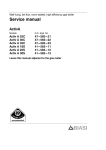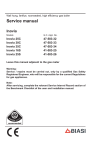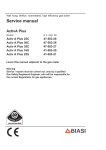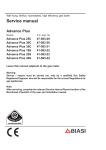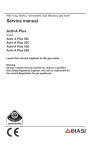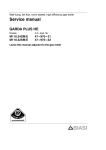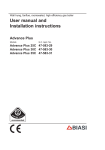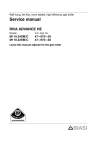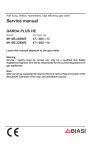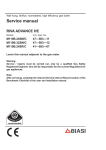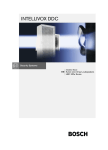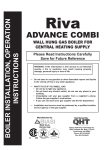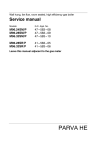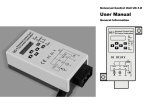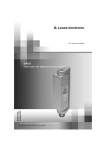Download Service
Transcript
Wall hung, fan flue, room sealed, high efficiency gas boiler Service manual ActivA Models: G.C. Appl. No. Activ A 12OV Activ A 15OV Activ A 20OV Activ A 25OV Leave this manual adjacent to the gas meter Warning Service / repairs must be carried out, only by a qualified Gas Safety Registered Engineer, who will be responsible for the current Regulations for gas appliances. Table of contents 1 1.1 1.2 Overall information . . . . . . . . . . . . . . . . . . Overall View . . . . . . . . . . . . . . . . . . . . . . . . . Hydraulic diagram . . . . . . . . . . . . . . . . . . . . 1 1 1 2 2.1 2.2 2.3 2.4 2.5 General access and emptying hydraulic circuits . . . . . . . . . . . . . . . . . . . . Nomenclature . . . . . . . . . . . . . . . . . . . . . . . . Case panels . . . . . . . . . . . . . . . . . . . . . . . . . Control panel . . . . . . . . . . . . . . . . . . . . . . . . Main electronic p.c.b. box . . . . . . . . . . . . . Emptying the primary circuit . . . . . . . . . . . 2 2 2 2 3 4 3 3.1 3.2 Diagrams . . . . . . . . . . . . . . . . . . . . . . . . . . . Wiring diagram . . . . . . . . . . . . . . . . . . . . . . . Circuit voltages . . . . . . . . . . . . . . . . . . . . . . 5 5 6 4 4.1 Fault finding . . . . . . . . . . . . . . . . . . . . . . . . Display diagnostic . . . . . . . . . . . . . . . . . . . . 7 9 5 5.1 5.2 5.3 Condensing heat exchanger . . . . . . . . . . Function . . . . . . . . . . . . . . . . . . . . . . . . . . . . . Removal . . . . . . . . . . . . . . . . . . . . . . . . . . . . Cleaning . . . . . . . . . . . . . . . . . . . . . . . . . . . . 10 10 10 11 6 6.1 6.2 6.3 6.4 6.5 6.6 6.7 Main electronic control/ignition p.c.b. . Function . . . . . . . . . . . . . . . . . . . . . . . . . . . . . Selection and adjustment devices . . . . . . Checking the temperature . . . . . . . . . . . . . Setting the boiler control function modes Checks . . . . . . . . . . . . . . . . . . . . . . . . . . . . . Removal of the electronic control p.c.b . . Thermal control in the ”c.h.” mode . . . . . 12 12 12 13 13 15 15 17 7 7.1 7.2 7.3 7.4 7.5 Control panel electronic p.c.b. . . . . . . . Function . . . . . . . . . . . . . . . . . . . . . . . . . . . . . Normaly information . . . . . . . . . . . . . . . . . . Info modality . . . . . . . . . . . . . . . . . . . . . . . . . Function modes setting modality . . . . . . . Removal of the control panel electr. p.c.b 18 18 18 19 19 19 8 8.1 8.2 8.3 8.4 8.5 Gas valve . . . . . . . . . . . . . . . . . . . . . . . . . . . Function . . . . . . . . . . . . . . . . . . . . . . . . . . . . . Description of the parts . . . . . . . . . . . . . . . Adjustment . . . . . . . . . . . . . . . . . . . . . . . . . . Checks . . . . . . . . . . . . . . . . . . . . . . . . . . . . . Removal of the gas valve . . . . . . . . . . . . . . 21 21 21 21 23 23 9 9.1 9.2 9.3 9.4 Temperature probe . . . . . . . . . . . . . . . . . . Function . . . . . . . . . . . . . . . . . . . . . . . . . . . . . Checks . . . . . . . . . . . . . . . . . . . . . . . . . . . . . Removal of the c.h flow temp. probe . . . . Removal of the c.h. return temp. probe . . 25 25 25 25 25 10 10.1 10.2 Fan and Air box . . . . . . . . . . . . . . . . . . . . . 27 Function . . . . . . . . . . . . . . . . . . . . . . . . . . . . . 27 Removal of the Fan and the Air box . . . . . 27 11 11.3 11.4 Ignition and detection electrodes and burner . . . . . . . . . . . . . . . . . . . . . . . . . . Function . . . . . . . . . . . . . . . . . . . . . . . . . . . . . Removal of the Ignition and detection electrodes . . . . . . . . . . . . . . . . . . . . . . . . . . . Removal of the burner . . . . . . . . . . . . . . . . Checks . . . . . . . . . . . . . . . . . . . . . . . . . . . . . 12 12.1 12.2 12.3 Safety thermostat . . . . . . . . . . . . . . . . . . . Function . . . . . . . . . . . . . . . . . . . . . . . . . . . . . Checks . . . . . . . . . . . . . . . . . . . . . . . . . . . . . Removal . . . . . . . . . . . . . . . . . . . . . . . . . . . . 30 30 30 30 13 13.1 13.2 13.3 Flue temperature probe NTC and Safety thermal fuse . . . . . . . . . . . . . . Function . . . . . . . . . . . . . . . . . . . . . . . . . . . . . Removal . . . . . . . . . . . . . . . . . . . . . . . . . . . . Checks . . . . . . . . . . . . . . . . . . . . . . . . . . . . . 31 31 31 31 14 14.1 14.2 14.3 Condensate trap . . . . . . . . . . . . . . . . . . . . Function . . . . . . . . . . . . . . . . . . . . . . . . . . . . . Check the cleanness of the trap . . . . . . . . Removal . . . . . . . . . . . . . . . . . . . . . . . . . . . . 32 32 32 32 15 Short spare parts list . . . . . . . . . . . . . . . . 33 11.1 11.2 28 28 28 28 28 1 Overall information 1.1 Overall View Flue temperature probe NTC C.h. flow temp. probe Safety thermostat Condensing heat exchanger air purger valve Condensing heat exchanger Electronic control box Burner Ighition electrodes Detection electrode Fan Air box (air/gas mixer) C.h. return temp. probe Gas restrictor C.h. pressure relief valve Gas valve Condensate trap Pipe silencer Control panel 1.2 Hydraulic diagram Central heating (c.h.) operation C.h. water flow C.h. water return C.h. water flow C.h. water return 1 2 General access and emptying hydraulic circuits 2.1 Nomenclature C 1 C 2 5 3 Fig. 2.3 To remove the side panels loosen the screws B (Fig. 2.2) and C (Fig. 2.3). 4 Pull the side panels towards the outside. To Fit the case panels Fig. 2.1 Fit the side case panels 1 Right side panel 2 Main electronic p.c.b. box Warning: 3 Front panel 4 Control panel 5 Left side panel 2.2 Fit the front panel hooking it on the upper side. Push the front case panel until it is completely hold in place (Fig. 2.4). Ensure that the front panel edge is close---fitting to the side panels. Case panels Lock in place the panel with the appropriate screws. Warning: isolate the boiler from the mains electricity supply before removing any covering or component. For the most part of the check and maintenance operations it is necessary to remove one or more panels of the case. The side panels can be removed only after the removal of the front panel. To remove the front panel loosen screws A (Fig. 2.2). A B Fig. 2.4 2.3 B Fig. 2.2 --- bottom view of the boiler Pull the lower part of the front panel and lift it upwards (Fig. 2.3). 2 Control panel Warning: isolate the boiler from the mains electricity supply before removing any covering or component. To gain access to the parts located inside the control panel proceed as follows: 1 Remove the front panel of the case. 2 Unscrew the screw D (Fig. 2.5) General access and emptying hydraulic circuits 3 Free the hooks indicated and rotate the lid towards left (Fig. 2.5). E Fig. 2.7 D 3 Slightly rotate the lid as indicated by the curved arrow and free the rear hooks. 4 Remove the lid. Main electronic p.c.b. lid removal Fig. 2.5 4 To access to the parts located inside the control panel turn it as shown in Fig. 2.6. To get access to the main electronic p.c.b.: 5 Pull the box that contains the electronic p.c.b. and rotate it (Fig. 2.8). Fig. 2.6 2.4 Main electronic p.c.b. box Warning: isolate the boiler from the mains electricity supply before removing any covering or component. To gain access to the parts located into main electronic p.c.b. box proceed as follows: 1 Remove the front panel of the case. Terminal block lid removal 2 To remove the terminal block lid E (Fig. 2.7), free the front hooks. Fig. 2.8 6 Remove the terminal block lid E (Fig. 2.7). 7 Free the hooks placed on the three sides indicated and rotate the lid towards left (Fig. 2.9). 3 General access and emptying hydraulic circuits 4 To help the draining of the primary circuit loose the condensing heat exchanger air purger valve G (Fig. 2.11) G Fig. 2.9 2.5 1 2 3 Emptying the primary circuit Close the c.h. circuit flow and return cocks. Remove the front and right panels of the boiler. Open the drain tap F (Fig. 2.10) until the boiler is completely emptied. Fig. 2.11 Attention: some water could remain in the condensing heat exchanger. 5 F CLOSED OPEN Fig. 2.10 4 Close drain tap once the emptying has been completed. Diagrams 3.1 Wiring diagram Gas valve 3 Condensate trap Fan 1 Ignition electrodes bu bn bu gnye M ~ bn gnye bu bk bu wh rd 4 Flame detection electrode gy gy 3 gy wh wh t bk C.h. return temp. probe NTC bk wh bu gy wh bk bu wh rd wh wh gy gy wh bn rd rd bu bk t bk Flue temp. probe NTC bn og og Fuse 2AF 250VAC 5x20 vt bu bu bk bk bu gnye bu t bu bk bn bk C.h. flow temp. probe NTC Safety thermostat bk bk Time switch (option) bk Remote External temp. probe terminal block Electric supply terminal block Room thermostat Pump terminal block bk rd rd N bu gnye L bn 3 ye 2 og 1 wh bn = brown bu = blue bk = black wh = white rd = red gy = grey vt og wh ye gn = green ye = yellow vt = violet og = orange gnye = green/yellow rdwh = red/white 5 Diagrams 3.2 Circuit voltages Electrical voltages with burner on Gas valve 230~ 0 230~ 230~ 230~ C.h. external pump during c.h. operation Supply network 6 Fan Safety thermostat 7 TD J L3 J J Er 17 Er 18 J J J J J J J J J J J J --- 5 Er 16 Er 15 --(4) J J J 14.1 Er 14 J Er 10 An 11 J J Er 09 Er 08 Er 06 Er 05 Er 04 Er 03 Er 02 Er 01 Defect # --(3) --(2) --(1) Power supply line Fault finding Section of the manual ! (note ref. in brackets) Appliance lock--- out (*) Gas supply line 4 Disp play indic i catess ”Err” Flue pipes Cond. drain pipe and trap C.h. circuit External pump Condensing heat exchanger Fuses (Electronic p.c.b.) J J 6.5 Main electronic p.c.b. Boiler settings J 8.4 7 Control panel electr. p.c.b. J J 9.2 J J J J J 10 Components to check Gas valve C.h. flow temp. probe C.h. return temp. probe Fan / air restrictor Ignition electrode J J 11.4 Detection electrode 12.2 12.2 13.1 J Safety thermostat Gas restrictor J J Flue temp. probe NTC --(7) Expansion vessel external J J --- J --- External temp. probe Pressure gauge external --- J --- Room themostat delayed Safety valve external Water leaks from the safety valve when the boiler is off. --- J J Power supply line J --(2) Gas supply line 1 Check for 230V~ between line (L) and neutral (N) Useful information can be obtained also from the optical indication given by the appliance display (see section 4.1). Note * Lock out is indicated as “Er” on the display. Water leaks from the safety valve during operation on c/h --- Noisy bolier Incorrect modulation The boiler does not start. The control panel display OFF Fan still. Defect # --(3) Flue pipes --(1) 4 2 3 --(4) C.h. circuit Fuses (Electronic p.c.b.) J 6.5 Main electronic p.c.b. J J J Control panel electr. p.c.b. J 8.4 C.h. flow temp. probe J J J J 10 Detection electrode Ignition electrode J J J J J J J --- --- --- --- 8 The boiler doesn’t reach the nominal heat input. Check the pressurization of the expansion vessel. Refer to the installation manual for proper values. 7 A jammed by--- pass could cause the over--- heating of the main circuit and the intervention of the safety thermostat. Safety thermostat Cond. drain pipe and trap --(7) Safety valve external Using the flue analyzer, check the CO2 value of the flue gases. This reading is a reference value for the gas valve setting. J 12.2 12.2 13.1 Pressure gauge external 6 5 Fan / air restrictor J 11.4 Gas restrictor 9.2 External temp. probe Components to check Gas valve 7 C.h. return temp. probe Boiler settings Verify the integrity of supply cable, plug and external fuses. Check the polarity of line and neutral connection Check the gas supply pipe and isolation tap for gas tightness. Check for soundness and absence of obstructions. Verify that the flue terminal is correctly installed (see clearances) and ensure that exhaust gas is not sucked back by the boiler. Check for soundness of the circuit and verify its correct filling (see also installation manual). J Condensing heat exchanger J --- External pump 5 Flue temp. probe NTC 14.1 Expansion vessel external Section of the manual ! (note ref. in brackets) Appliance lock--- out (*) No ”Er” iindication on on display Room themostat delayed 8 4.1 Display diagnostic The display indications provide help in the diagnosis of fault finding. The control panel display gives other information for the user. The following table gives fault code, error and the reson for the fault. Er 01 + RESET Lack of burner ignition Er 02 + RESET Safety thermostat lockout Er 03 + RESET Other faults Er 04 + Faulty primary circuit (no water or absence of flow) Er 05 + Faulty fan control system Er 06 + Faulty c.h. temperature probe NTC Er 08 + Faulty external temperature probe NTC (if fitted) Er 09 + Faulty flue temperature probe NTC Er 10 + RESET Lockout --- flue temperature probe NTC (Flue temperature > 120 ˚C) Faulty pump (absence of water Er 14 + RESET flow in the main circuit) or primary temperature above 105 ˚C None or too low water flow; Faulty Er 15 + RESET pump (temp. difference between probes higher than 35˚ C) Possible exchange of NTC probes Er 16 + RESET (Flow or Return) or pump wrongly mounted (upside --- down) Er 17 + RESET Faulty c.h. temperature probe NTC (Flow or Return) Er 18 + RESET Faulty primary circuit (no water or absence of flow) L3 Useful output limitation (temperature difference between probes higher than 25˚ C) : Boiler test performing Td Thermostat Delayed : Boiler test performing An 11 Parasite flame 9 5 Condensing heat exchanger 5.1 Function N K The Condensing heat exchanger A in Fig. 5.1 has the function of transferring heat produced from combustion of the gas and from the flue exhausted gas to the water circulating in it. Y Y J S I A H N L X C F G E B F Fig. 5.1 Fig. 5.2 By reducing the combustion products temperature, the latent heat of the vapour is transferred to the water circuit, allowing an extra gain of useful heat. 13 Disconnect the fan connector M by pressing the plastic hook placed on the side of the connector (Fig. 5.4). The condensed vapour is then drained through the condensate trap B and the draining pipe C. 5.2 Removal Warning: isolate the boiler from the mains electricity supply before removing any covering or component. 1 2 3 4 5 6 7 8 9 10 11 12 10 Turn off the gas supply. Remove all the case panels (see section 2). Disconnect the flue system from the boiler. Disconnect the air manifold D (Fig. 5.4) by pulling it. Disconnect the rubber pipe E (Fig. 5.2). Unscrew the gas connectors F. Remove gas pipe G . Unscrew the screws and remove the detection electrode connector H. Unscrew the screws and remove the ignition electrodes connector I . Unscrew the screw and remove the overheat thermostat J . Disconnect the connector K by pressing the plastic hook placed on the side of the connector. Disconnect the connector L P O Fig. 5.3 14 15 16 Empty the primary circuit of the boiler. Remove the forks N (Fig. 5.2). Loosen the connection O and remove the pipe P (Fig. 5.3) from the Condensing heat exchanger. Condensing heat exchanger 17 18 19 Loosen the connection Q and remove the pipe R (Fig. 5.4) from the Condensing heat exchanger. Unscrew the screws S . Remove the fan---burner group. V 22 23 24 25 Q M X R W D Loosen the screws X (Fig. 5.4 --- Fig. 5.2) Unscrew the screws Y (Fig. 5.2). Remove the Condensing heat exchanger slightly move it upwards, turn it frontwards freeing it from the below screws X (Fig. 5.4 --- Fig. 5.2) and then extract it forwards. Reassemble the Condensing heat exchanger carrying out the removal operations in reverse order. Ensure to tighten the screws S --- Fig. 5.2 firmly 5.3 Cleaning If there are deposits of dirt between the fins of the Condensing heat exchanger, clean with a bristle paintbrush and remove the dust with a hoover. Warning: After cleaning or replacement as detailed above, it is deemed necessary to undertake a combustion analysis as detailed in chapter 8.3 section 11. Fig. 5.4 20 21 Unscrew the screws T and remove the plate U (Fig. 5.5). Remove the forks V and remove the condensate trap W moving it downwards (Fig. 5.4). U T Fig. 5.5 11 6 Main electronic control/ignition p.c.b. 6.1 Function Inlet Information On the Main electronic control/ignition p.c.b....... Function control C.h. temperature adjustment Boiler reset button (printed circuit board p.c.b.) From other boiler devices.... C.h. flow temperature probe NTC C.h. return temperature probe NTC Flue temperature probe NTC Safety thermostat Flame detection electrode Room thermostat (if fitted) Time switch (if fitted) Outlet command External Pump Gas valve Fan Ignition electrodes Display indicates “Er”* *control panel electronic p.c.b. The fundamental function of the Main electronic control/ignition p.c.b. is that of controlling the boiler in relation to the external needs (i.e. heating the dwelling) and operating in order to keep the temperature of the hydraulic circuits constant. This is obviously possible within the useful power and maximum working temperature limits foreseen. Generally, the Main electronic control/ignition p.c.b. receives inlet information coming from the boiler (the sensors) or from the outside (printed circuit board p.c.b., room thermostat, etc.), processes it and consequently acts with outlet commands on other components of the boiler (Fig. 6.1). The Main electronic control/ignition p.c.b. is also a full sequence ignition device and does a sequence of operations (ignition cycle) which lead to the ignition of the gas at the burner It checks the presence of the flame during the entire period in which it is activated and supplies the fan regulating its speed. The Main electronic control/ignition p.c.b. has a safety function and any incorrect interventions or tampering can result in conditions of dangerous functioning of the boiler. The Main electronic control/ignition p.c.b. can lock the functioning of the boiler (lock state) and stop its functioning up to the resetting intervention. The lock ---out is signalled on the display of the control panel electronic p.c.b. and can be reset only by using the boiler reset button placed on the printed circuit board p.c.b. (see section 7.1). Some components which are connected to the device can activate the lock state. The causes of a lock state could be: f The intervention of the safety thermostat (overheat of the primary circuit). f The intervention of the flue temperature probe (overheat of the combustion products). f A fault on gas supply. f Faulty ignition (faulty ignition electrodes, their wiring or connection). f Faulty flame detection (faulty detection electrode, its wiring or connection). f Faulty condensate drainage. f Faulty gas valve (faulty on---off operators or not electrically supplied). f Faulty Main electronic control/ignition p.c.b.. Other components like the c.h. temperature probes NTC switch can temporarily stop the ignition of the burner but allow its ignition when the cause of the intervention has stopped. NO TAG and Fig. 6.12 show the sequence of the operations that are carried out at the start of every ignition cycle and during normal functioning. 6.2 Fig. 6.1 12 Selection and adjustment devices On the Main electronic control/ignition p.c.b. several selection, adjustment and protection devices are located. (Fig. 6.2). Main electronic control/ignition p.c.b. Some of these devices are directly accessible by the user (function control, temperature adjustment etc.) others, like the fuses, are accessible by removing the main electronic p.c.b. lid. 1 2 3 4 5 During the c.h. operation (Fig. 6.3), the signal coming from the c.h. temperature probe is compared to the signal given by the control panel p.c.b. through the adjustment made by the user (key ). The result of such a comparison operates the fan speed thus regulating the gas flow rate and consequently changing the useful output of the boiler. 6 13 12 7 11 8 10 9 Fig. 6.2 1 Connector --- ignition electrode. 2 Connector --- flame detection electrode. 3 Connector --- controler fan. 4 Connector ---c.h. return temperature probe NTC 5 Connector --- flue temperature probe NTC. 6 Connector --- external temperature probe (optional). 7 Connector --- safety thermostat and c.h. flow temperature probe NTC. 8 Connector --- remote control (optional). 9 Connector --- display and function control / c.h. temperature adjustment control panel p.c.b. Fig. 6.3 10 Fuse F1, F2 2A F 11 Connector --- electric supply Main electronic control/ignition p.c.b. 12 Connector --- electric supply control panel p.c.b. 6.4 13 Connector --- gas valve, external pump and fan. It is possible to select the various boiler control function modes hereafter named “parameters” by using the keys of the control panel p.c.b. 6.3 Checking the temperature The control sequences in c.h. function are illustrated in detail in section 6.7. Setting the boiler control function modes The Main electronic control/ignition p.c.b. makes it possible adjust the c.h. water flow temperature. A The temperature of the water is converted into an electric signal by means of temperature probes. The user, setting the desired temperature with the control panel p.c.b. key If the power requested is lower than 40% of the maximum power output then control is achieved by switching ON the burner at minimum power, then switching OFF (ON/OFF function). If the power requested is higher, then the burner is switched ON at maximum power and will control by modulating to 40% of the maximum power output. B C Fig. 6.4 1 To enter in the parameters setting mode press contemporary the 3 keys (A --- B --- C Fig. 6.4) for 10 second until the display shows Fig. 6.5 13 Main electronic control/ignition p.c.b. B Fig. 6.9 7 Fig. 6.5 2 To exit for setting without modifing the set press the keys (B --- C Fig. 6.10) To move through the parameters press c.h. set keys (A or C Fig. 6.6) B A C C Fig. 6.10 To reset the boiler to the normal operation press contemporary the 3 keys (A --- B --- C Fig. 6.4) for 10 second. Fig. 6.6 3 The display shows Fig. 6.7 The following table gives details of each parameter and the possible value that can be set. Important: at the end of the setting operation it is important to fill/update the table in the installation manual see chapter COMMISSIONING section: Setting record. PARAMETER DIGIT VALUES Boiler type (to be up- Pr 01 dated with the complete range) 00 = No power Er 99 18 = Activ A 12OV 19 = Activ A 15OV 20 = Activ A 20OV 21 = Activ A 25OV Not used Pr 02 Fig. 6.7 Not used Pr 03 4 Not used Pr 04 Gas type Pr 05 A Not used Pr 06 B C.h. flow max temperature ˚C Pr 07 85 ÷ 45 (factory set 85 ˚C) Factory parameters Pr 08 reset 00 = No reset 04 = All parameters return to factory set with the exclusion of Pr 01 and Pr 05 39 = All parameters return to factory set included Pr 01 and Pr 05 To modify the parameter press contemporary the keys (A --- B Fig. 6.8) Fig. 6.8 5 To change the parameters press c.h. set keys (A or C Fig. 6.6) 6 To memorize the setting press the key (B Fig. 6.9) 14 00 = G20 Natural 05 = G31 Propane Main electronic control/ignition p.c.b. PARAMETER Chimney function DIGIT VALUES sweep Pr 09 00 = No chimney sweep fun (factory set) 01 = Low power sweep---test 04 = C.h. power sweep---test 07 = D.h.w. power sweep---test C.h. reignition fre- Pr 10 quency 00 ÷ 99 (0÷600 sec.) (factory set 30 = 3 minutes) C.h. pump post ---cir- Pr 11 culation 00 ÷ 99 (0÷600 sec.) (factory set 10 = 1 minute) Max. useful output in Pr 12 c.h. mode 00 ÷ 99 (0÷100%) factory set: 99 = Activ A 12OV 99 = Activ A 15OV 99 = Activ A 20OV 99 = Activ A 25OV C.h. pump working Pr 13 type Ignition power Pr 14 NTC on the c.h. re- Pr 18 turn Pr 19 Not used Pr 20 Not used Pr 21 Not used Pr 22 Not used Pr 23 Not used Pr 24 Not used Pr 25 Not used Pr 26 C.h. minimum set- Pr 27 point 25 ÷ 45 (factory set 25 ˚C) Tab. 6.1 6.5 n Checks Check that the fuses are complete If the Main electronic control/ignition p.c.b. does not supply any device (pump, fan, etc.) check that the fuses 10 (Fig. 6.2) are complete. 00 ÷ 99 (0÷100%) factory set: Start the boiler until the burner is ignited. 01 (=0,1)÷60 (=6,0) K value factory set: 00 = Off Pr 16 D.h.w. burner turn off Pr 17 function Not used If a fuse has blown replace it with one that has the same characteristics after having identified the reason for failure. Propane (G31) 40 = Activ A 12OV 40 = Activ A 15OV 40 = Activ A 20OV 40 = Activ A 25OV Not used DIGIT VALUES 00 = Depends on room thermostat (factory set) 04 = Always running Natural gas (G20) 30 = Activ A 12OV 30 = Activ A 15OV 30 = Activ A 20OV 40 = Activ A 25OV K value (external Pr 15 probe diagram) PARAMETER 00 = Burner off at fixed d.h.w. = 65 ˚C (factory set) 01 = Brurner off at set point +5 ˚C 00 = Probe not present (factory set) 01 = Probe present n Lock sequence With the burner firing, interrupt the gas supply. The Main electronic control/ignition p.c.b. must carry out four complete ignition cycles and then, after about 4 minutes, goes to lock ---out state. Switch off and on the electricity supply to the boiler, by means of the fused spur isolation switch, the device must not unlock and the burner must not turn on 6.6 Removal of the electronic control p.c.b Warning: isolate the boiler from the mains electricity supply before removing any covering or component. When replacing the Main electronic control/ignition p.c.b. all parameters must be correctly checked / adjusted accordingly with the values noted in table in the installation manual see chapter COMMISSIONING section: Setting record (for information on parameters see also section 6.4). 1 Remove all the body panels (see section 2.2). 2 Gain access to the parts located inside the Main electronic p.c.b. box as explained in the section 3 2.4 of this manual. Remove all the wiring connected to the Main electronic control/ignition p.c.b.. 15 Main electronic control/ignition p.c.b. 4 5 Delicately flex the hooks D in the directions indicated (Fig. 6.11) in order to release the circuit from the box. Remove the Main electronic control/ignition p.c.b.. 6 Re---assemble the Main electronic control/ignition p.c.b. following the removal procedures in the reverse order. Important When re---assembling the Main electronic control/ignition p.c.b.: 7 It is not necessary to utilise static protections but it is advisable to ensure that the pcb is handled with care and held at the edges and with clean dry hands. Attention After installing the Main electronic control/ignition p.c.b. properly set the parameters. D Fig. 6.11 16 D Warning: After cleaning or replacement as detailed above, it is deemed necessary to undertake a combustion analysis as detailed in chapter 8.3 section 11. Main electronic control/ignition p.c.b. 6.7 Thermal control in the ”c.h.” mode Switch in the c.h. function mode circulator off fan still Request for heat from room thermostat? NO circulator on YES Is primary circuit temperature higher than that selected? YES Temp. difference between probes higher than 35˚ C ? NO YES stop circulator (3min) NO YES NO lock memorised? cancels lock starts fan checks fan rpm Is fan rpm exact? NO YES Is flue temperature higher than 110˚C? NO YES beginning of wait period flame presence? End of wait period? YES starts ignition discharges Opens gas valve beginning of ignition period YES NO flame presence? interrupts ignition discharges gas valve open fan runs YES NO NO End of ignition period? YES closes gas valve stops fan interrupts ignition discharges memorizes lock display show lock--- out NO Is fan rpm exact? NO NO YES safety thermostat or flue temperature probe lock out? YES reset key pressed? flame presence? YES NO YES Fig. 6.12 17 7 Control panel electronic p.c.b. LCD FUNCTION 7.1 Function Er 17 + RESET Faulty c.h. temp. probe NTC (Flow or Return) Er 18 + RESET Faulty primary circuit (no water or absence of flow) Er 04 + Faulty primary circuit (no water or absence of flow) Er 05 + Faulty fan control system Er 06 + Faulty c.h. temp. probe NTC Er 08 + Faulty external temp. probe NTC Er 09 + Faulty flue temp. probe NTC D A B C Fig. 7.1 A) C.h. temperature increase key B) C.h. temperature reduce key C) Reset/Stand---by/Winter/Summer key D) Display The Control panel electronic p.c.b. can give to the service 3 levels of informations: f Normally information f Info modality f Function modes setting modality 7.2 Normaly information KEY RESET The symbol indicates that the boiler can be directly reactivated by the user, by pressing the reset button. Boiler Stand---By (anti---freeze protection activaded) Boiler waiting for heat request. Boiler in winter mode. The primary circuit temperature is displayed. Boiler on demand for c.h. power. The symbol indicates that the fault requires intervention on behalf of specialised technical assistance. Burner ignition (spark) All symbols represented with lines that surround them, indicate that the symbol is flashing. Flame present (Burner on) SIGNAL DISPLAYED BY THE LCD LCD FUNCTION Er 01 + RESET Lack of burner ignition on safety lockout Er 02 + RESET Safety thermostat intervention lockout Boiler in anti---freeze phase (bP flasching + temperature flashing) Boiler in antifrost phase (AF flasching + temperature flashing) Er 03 + RESET General lockout Er 10 + RESET Flue probe interven lockout Er 14 + RESET Faulty pump or primary temperature above 105˚ C None or too low water flow; Faulty Er 15 + RESET pump (temp. difference between probes higher than 35˚ C) Possible exchange of NTC probes Er 16 + RESET (Flow or Return) or pump wrongly mounted (upside --- down) 18 Set c.h. (all other symbols are disabled) Pump activated for the post ---circulation phase (Po flashing + temperature flashing) Control panel electronic p.c.b. LCD FUNCTION Description Parameter Value Delayed burner ignition for setting the system (uu flashing + temperature flashing) External temperature ˚C (if fitted) d1 -- 5 K value (external probe dia- d2 gram) (the value is x 10) 12 Boiler in chimney sweep functioning mode. The chimney sweep is activated by setting “parameter 09=01” and is visualised by the switching on of the hand and alternate flashing between the tempereture and the communication and radiator symbol. Offset (Transaltion of K diagram d3 ± 15˚C) -- 10 C.h. temperature ˚C (calcu- d4 lated by external sensor) 66 C.h. flow temperature ˚C d5 78 C.h. return temperature ˚C d6 44 Flue temperature ˚C d8 67 Thermostat Delayed: Boiler test performing. Fan speedy (the value has to d9 be x 100 = 4400 rpm) 44 SW version BC (burner control) dc 01 dd 03 Useful output limitation (temp. difference between probes higher than 25˚ C): Boiler test performing. Flame detection error (An flasching + error flashing number) 7.3 Info modality The INFO mode allows the display of some information on the boiler functioning status. In case of malfunctioning of the boiler, it may be useful to communicate such information to the Authorised Service Centre Engineer so that the causes can be understood. In order to access the INFO mode, press keys A and C (Fig. 7.1) at the same time until the letter di appears on the display that alternates with a code (Fig. 7.2). SW version MB (main board) Tab. 7.1 7.4 Function modes setting modality It is possible to select the various boiler control function modes hereafter named “parameters” by using the keys of the control panel p.c.b. During the function modes setting, the boiler does not operate. To get in function modes setting modality see section 6.4 7.5 Removal of the control panel electronic p.c.b Warning: isolate the boiler from the mains electricity supply before removing any covering or component. 1 2 3 Remove all the body panels (see section 2.2). Gain access to the parts located inside the Control panel electronic p.c.b. as explained in the section 2.3 of this manual. Remove all the wiring A connected to the Control panel electronic p.c.b. (Fig. 7.3). Fig. 7.2 To scroll the values press B (reduce) and A (increase). keys (Fig. 7.1). In order to exit the INFO mode, hold keys A and C (Fig. 7.1) pressed at the same time. The following table gives details of each parameter and the possible value that can be show. 19 Control panel electronic p.c.b. 4 5 6 7 C C B A A B C Fig. 7.3 20 Unscrew the screws B Delicately flex the hooks C in the directions indicated (Fig. 7.3) in order to release the circuit from the box. Remove the Control panel electronic p.c.b.. Reassemble the Control panel electronic p.c.b. carrying out the removal operations in the reverse order. 8 Gas valve 8.1 Function The Gas valve A in Fig. 8.1 controls the gas inflow to the boiler burner. 1 2 3 Maximum gas pressure adjustment Minimum gas pressure adjustment On---off operators 4 5 On---off operators electric connector Gas valve inlet pressure test point 8.3 Adjustment Warning: isolate the boiler from the mains electricity supply before removing any covering or component. Check the supply pressure before making any adjustment to the gas valve. 1 Close the gas inlet valve. 2 Remove the front panel of the case and lower the control panel (see sections 2.2 and 2.3). Loosen the internal screw on the Inlet Pressure Test Point 5 (Fig. 8.2) of the Gas valve and connect a pressure gauge using a suitable hose. 3 A 4 5 Open the gas inlet valve. Turn on the electricity supply to the boiler, switching on the fused spur isolation switch. 6 Set the boiler in c.h. function as illustrated in Fig. 8.3 Fig. 8.1 C.h. function By means of an electric command given to the on---off operators the passage of the gas through the Gas valve can be opened or closed. 8.2 Description of the parts (Fig. 8.2) Fig. 8.3 7 8 1 2 9 10 3 Disconnect the pressure gauge and close the Inlet Pressure Test Point 5 (Fig. 8.2). Gas valve adjustment The person carrying out a combustion measurement should have been assessed as competent in the use of a flue gas analyser and the interpretation of the results. The flue gas analyser used should be one meeting the requirements of BS7927 or BS-- EN50379-- 3 and be calibrated in accordance with the analyser manufacturers’ requirements, and have a current calibration certificate. 4 5 11 Fig. 8.2 Make sure that the room thermostat is in the “heat request” position. Read the inlet pressure value and ensure that it is within the limits given in the table Gas supply pressures, of the user/installation manual If it does not comply with the required pressure check the gas supply line and governor for faults and/or correct adjustment. Switch off the boiler close the gas inlet valve. Fit the probe of the flue analyser in the flue exhaust sampling point located on the exhaust pipes of the boiler (Fig. 8.4). 21 Gas valve flue exhaust sampling point air intake sampling point Fig. 8.7 Fig. 8.4 12 Turn on the boiler, switching on the fused spur isolation switch. 13 Open the gas inlet valve. 14 Turn on the boiler and operate for 2 minuets to pre---heat the flue, before commencing any adjustments A B C 17 Make sure that the room thermostat is in the “heat request” position. 18 Allow the analyser to give a stable reading. 19 Read the CO2 % value. It should be between: Model Type gas CO2 % value (range) Activ A 12OV A ti A 15OV Activ Natural (G20) 8,2 --- 9,0 Propane (G31) 9,2 --- 10,2 Activ A 20OV A ti A 25OV Activ Natural (G20) 8,2 --- 9,2 Propane (G31) 9,2 --- 10,2 Tab. 8.1 Fig. 8.5 To adjust the CO2 % value remove the brass plug by unscrewing it and rotate the Allen key screw ø 4 mm (2 --Fig. 8.2) (by rotating it clockwise the CO2 % increases). 15 Checking the maximum gas valve setting To enter in the parameters setting mode press contemporary the 3 keys (A --- B --- C Fig. 8.5) for 10 second until the display shows Fig. 8.6 20 Press key A to vary the output in chimney sweep mode: when the display shows the letters cP that alternate with the heating water temperature value (e.g.60), the ”chimney sweep function” is at maximum output in heating mode (Fig. 8.8); Fig. 8.6 Adjusting minimum gas valve setting 16 22 Press keys A and C (Fig. 8.5) at the same time until the display shows the letters LP that alternate with the heating water temperature value (e.g.45), indicating the activation of the ”chimney sweep function” at minimum output (Fig. 8.7). Fig. 8.8 21 Press further key A. The display shows the letters dP that alternate with the heating water temperature value (e.g.60)(Fig. 8.9). On this models this step is not relevant and the value shown is the same of the step 20. No setting is needed on this step. Gas valve ON---OFF Operator approx. 6 400 Ω* ON---OFF Operator approx. 920 Ω* * at ambient temperature. Fig. 8.11 8.5 Warning: isolate the boiler from the mains electricity supply before removing any covering or component. Fig. 8.9 22 Allow the analyser to give a stable reading. 23 Read the CO2 % value. It should be between: 1 Model Type gas CO2 % value (range) Activ A 12OV Activ ct A 15OV 5O Activ A 20OV Activ A 25OV Natural (G20) 8,9--- 9,8 Propane (G31) 9,9 --- 10,8 Removal of the gas valve Remove the front panel of the case as explained in the section 2.3 of this manual. Disconnect the connector D (Fig. 8.12). Unscrew the screws E and disconnect the earth connector F. 2 3 Tab. 8.2 J To adjust the CO2 % value rotate screw (1 --- Fig. 8.2) (by rotating it clockwise the CO2 % decreases). 24 I F Press keys A --- B --- C (Fig. 8.5) at the same time again to exit the ”chimney sweep mode” and return to the previously set boiler status (Fig. 8.10) G E D C.h. function I H Fig. 8.10 25 Switch off the boiler and turn off the room thermostat. K 26 Close the air---flue sampling points. 27 After adjustment fit the protective brass plug (2, Fig. 8.2). 4 Important: after the gas pressure checks and any adjustment operations, all of the test points must be sealed. 5 8.4 Checks Warning: isolate the boiler from the mains electricity supply before removing any covering or component. Fig. 8.12 6 7 8 Turn off the gas supply and disconnect the gas isolation cock connector from the inlet port of the gas valve. Using pliers, remove the spring G and the rubber pipe H (Fig. 8.12). Unscrew the connectors I (Fig. 8.12) and remove the pipe J . Unscrew the screws K and remove the valve (Fig. 8.12). Reassemble the valve carrying out the removal operations in reverse order. n Check the on---off operators coils 1 Remove the front panel of the case. Before fitting a new valve, it is advisable to pre-- set it as follows. 2 Disconnect the electrical connector 4 (Fig. 8.2). 9 3 Measure the electrical resistance between the connector pins of the on---off operators as illustrated in Fig. 8.11. 10 Remove the brass plug and turn the plastic screw inside it fully clockwise until it stops. Do not overtight. Turn it counter---clockwise 2 and 3/4 turns. 23 Gas valve 11 Adjust the gas valve using the flue analyser as described in section 8.3. After any service operation on the components of the gas circuit check all the connections for gas leaks. Warning: After cleaning or replacement as detailed above, it is deemed necessary to undertake a combustion analysis as detailed in chapter 8.3 section 11. 24 9 Temperature probe 9.1 Function 9.2 The Temperature probe has the function of converting the temperature of the water in the hydraulic circuit where it is installed into an electrical signal (resistance). The relation between temperature and electrical resistance is stated in Fig. 9.1. Ω 12500 n Checks Temperature---resistance relationship Warning: isolate the boiler from the mains electricity supply before removing any covering or component. Disconnect the cable from the Temperature probe. Measure the temperature of the pipe C (c.h. flow Temperature probe)(Fig. 9.3) or of the pipe D (c.h. return Temperature probe)(Fig. 9.4) where the Temperature probe is located and check the electrical resistance according to the graph in Fig. 9.1. 12000 11500 11000 10500 10000 9500 9000 8500 8000 7500 7000 6500 6000 5500 5000 4500 4000 3500 3000 2500 2000 1500 1000 500 9.3 Removal of the c.h flow Temperature probe Warning: isolate the boiler from the mains electricity supply before removing any covering or component. 20 25 30 35 40 45 50 55 60 65 70 75 80 85 90 95 100 1 Remove all the case panels. 2 Remove the electric connector E and remove the c.h. Temperature probe A --- Fig. 9.3 3 Reassemble the c.h. flow Temperature probe carrying out the removal operations in reverse order. ˚C Fig. 9.1 On the boiler there are two Temperature probes. One on the output of the primary condensing heat exchanger (c.h. flow Temperature probe) A in Fig. 9.2 and Fig. 9.3; one on the inputof the primary condensing heat exchanger (c.h. return Temperature probe) B in Fig. 9.2 and Fig. 9.4. c.h. flow E c.h. return A A C B Fig. 9.3 9.4 Removal of the c.h. return Temperature probe Warning: isolate the boiler from the mains electricity supply before removing any covering or component. Fig. 9.2 1 Remove all the case panels. 2 Remove the electric connector F and c.h. return Temperature probe B --- Fig. 9.4 3 Reassemble the c.h. return Temperature probe carrying out the removal operations in reverse order. 25 Temperature probe F B D Fig. 9.4 26 10 Fan and Air box 10.1 Function The function of the Fan A (Fig. 10.1) is to force the mixture of air and gas into the burner. The function of the Air box B is to mix the gas and the air in the right proportion. The flow rate of the air---gas mixture and consequently the input power of the boiler is proportional to the speed of the fan that is controlled by the electronic control p.c.b. 3 Disconnect the rubber pipe C (Fig. 10.2). 4 Unscrew the gas connectors D and remove the gas pipe E. 5 Disconnect the connector F 6 Disconnect the fan connector G by pressing the plastic hook placed on the side of the connector. 7 Unscrew the screws H. 8 Remove the fan A with the air box B. 9 Remove the screws I and the air box B (Fig. 10.3). A I I B B I Fig. 10.3 10 Open the strip J by sliding the edges with the help of a screwdriver and remove the Air box Fig. 10.4. J Fig. 10.1 10.2 B Removal of the Fan and the Air box Warning: isolate the boiler from the mains electricity supply before removing any covering or component. 1 Turn off the gas supply. 2 Remove all the case panels (see section 2). F G Fig. 10.4 E 11 D H A Assemble the Fan and the Air box carrying out the removal operations in reverse sequence. Before reassembling ensure the (Fig. 10.2) is correctly mounted. fan gasket After any service operation on the components of the gas circuit check all the connections for gas leaks. C Fig. 10.2 D Fan gasket Warning: After cleaning or replacement as detailed above, it is deemed necessary to undertake a combustion analysis as detailed in chapter 8.3 section 11. 27 11 Ignition and detection electrodes and burner 2 11.1 Function 3 Three electrodes are fitted on the fan---burner group. Two of them, fitted on the right side of the fan---burner group A, are the ignition electrodes B 4 On the left side is the detection electrode C and it detects the presence of the flame. Disconnect the ignition electrodes connector E and the earth wire F (Fig. 11.1) and disconnect the detection electrode connector G. Unscrew the screws H and remove the ignition electrodes B and the detection electrode C (Fig. 11.1). Assemble the Ignition and detection electrodes carrying out the removal operation in reverse order. 11.3 Removal of the burner Warning: isolate the boiler from the mains electricity supply before removing any covering or component. F 1 2 H 3 B H A Remove the air box and the fan (see section 10.2) Unscrew the screws I (Fig. 11.1 ) and remove the fan---burner duct A. Remove the burner by sliding it forward. locating tab I H C E G Fig. 11.1 The burner D is fitted on the rear of the fan---burner group A. burner gasket Fig. 11.3 4 Assemble the burner carrying out the removal operation in reverse order. Ensure the burner is correctly located by lining up the locating tab (Fig. 11.3). Before reassembling ensure the burner gasket is correctly located. Warning: After cleaning or replacement as detailed above, it is deemed necessary to undertake a combustion analysis as detailed in chapter 8.3 section 11. D 11.4 n Fig. 11.2 11.2 1 28 Remove all the case panels (see section 2) . Check the position of the electrode edges Warning: isolate the boiler from the mains electricity supply before removing any covering or component. Removal of the Ignition and detection electrodes Warning: isolate the boiler from the mains electricity supply before removing any covering or component. Checks 1 2 Remove the ignition electrodes (see section 11.2) Check for the correct distance between the metallic edges of the ignition electrode (see Fig. 11.4). Ignition and detection electrodes earth electrode n Check the connection wires. 3,5 mm Ignition electrode Fig. 11.4 29 12 Safety thermostat 12.1 Function The safety thermostat A in Fig. 12.1 is a device that senses the temperature of the primary circuit water which flows in the outlet pipe of the condensing heat exchanger. If the temperature control system of the boiler fails and the temperature of the primary circuit reaches a dangerous temperature, the safety thermostat opens the electric circuit that supplies the on---off operators of the gas valve. Consequently, the full sequence ignition device attempts to light the burner and, at the end, locks the boiler and lights the lock ---out on the display. Warning: isolate the boiler from the mains electricity supply before removing any covering or component. n 1 2 Electrical function Remove all the case panels. Disconnect the safety thermostat and check its electrical function. Normally (no intervention) the contact must be closed (electrical resistance zero Ω). 12.3 Removal Warning: isolate the boiler from the mains electricity supply before removing any covering or component. 1 2 3 A Remove all the case panels. Disconnect the wiring B (detail in Fig. 12.2). Unscrew the screws C and remove the safety thermostat. B C Fig. 12.1 12.2 Fig. 12.2 Checks n Overheat temperature value 1 Run the boiler and set the temperature at maximum by pressing the appropriate key. 2 Allow the boiler to reach its maximum operating temperature. The boiler should maintain a temperature below that of the safety thermostat and no overheat intervention should occur. 30 4 5 Reassemble the safety thermostat carrying out the operations in reverse order. Apply an adequate quantity of heat conducting compound between the condensing heat exchanger and the thermostat. Warning: After cleaning or replacement as detailed above, it is deemed necessary to undertake a combustion analysis as detailed in chapter 8.3 section 11. 13 13.1 Flue temperature probe NTC and Safety thermal fuse 13.2 Warning: isolate the boiler from the mains electricity supply before removing any covering or component. Function The Flue temperature probe NTC A in Fig. 13.1 and Fig. 13.2 senses the temperature of the combustion products that flow through the condensing heat exchanger. Removal 1 Remove all the case panels. 2 Disconnect the connector B from the Flue temperature probe NTC by pressing the plastic hook placed on the side of the connector. 3 Unscrew and remove the flue temperature probe A (Fig. 13.2) from the condensing heat exchanger. 4 Assemble the Flue temperature probe NTC carrying out the removal operations in reverse sequence. A 13.3 Checks n Overheat temperature value 1 Run the boiler and set the temperature at maximum by pressing the appropriate key. 2 Allow the boiler to reach its maximum operating temperature. The boiler should maintain a temperature below that of the Flue temperature probe NTC and no overheat intervention should occur. Fig. 13.1 n Temperature---resistance relationship If the temperature of the combustion products circuit reaches the limit temperature, the Flue temperature probe NTC reduces the gas flow rate to the burner. The temperature of the combustion products should decrease to a safe value temperature. 1 Remove the Flue temperature probe NTC (see section 13.2). 2 Measure the Flue temperature probe NTC electrical resistance at the ambient temperature and check it according to the graph in Fig. 13.3 In the case that the temperature of the combustion products reaches a potentially dangerous value, it stops the boiler operation (lock ---out). This allows the use of plastic materials for the flue outlet pipes and bends. The use of kits different from the original isn’t however allowed, since the flue pipes are integral parts of the boiler. A B Ω 12500 12000 11500 11000 10500 10000 9500 9000 8500 8000 7500 7000 6500 6000 5500 5000 4500 4000 3500 3000 2500 2000 1500 1000 500 20 25 30 35 40 45 50 55 60 65 70 75 80 85 90 95 100 Fig. 13.2 ˚C Fig. 13.3 31 14 Condensate trap 14.1 Function Unscrew the plug D on the bottom of the trap A and remove dirt eventually deposit (Fig. 14.3). The condensate trap A in Fig. 14.1 and Fig. 14.3 allows the discharge of the condensate via the condensate drain pipe avoiding in the mean time the escape of combustion products. A plastic ball closes the trap outlet in case that the trap is empty. 14.3 Removal Warning: isolate the boiler from the mains electricity supply before removing any covering or component. 1 2 Remove the front and right case panels. Unscrew the screws B and remove the plate C (Fig. 14.2) Unscrew the threaded locking ring E and remove the flexible pipe F (Fig. 14.3). Disconnect the electric connector G (Fig. 14.3 --Fig. 14.4) 3 4 H G F A E A D G Fig. 14.1 If the drain pipe becomes blocked, or condensate cannot drain, the condensate level it the trap rises until it reaches the screw attached to the flame detection electrode, this will cause the boiler lock ---out. 14.2 1 Fig. 14.3 Remove the forks H and remove the condensate trap A moving it downwards (Fig. 14.3). 5 Check the cleanness of the trap Unscrew the screws B and remove the plate C (Fig. 14.2). G C B Fig. 14.4 6 Fig. 14.2 32 Reassemble carrying out the removal operations in reverse order. 15 Short spare parts list Key G.C. part no. Description 1 Burner (mod. Activ A 12OV, Activ A 15OV Activ A 20OV) 2 Q.ty ManufacManufacturer’s reference turer part no. 1 BI1313 100 Burner (mod. Activ A 25OV) 1 BI1313 101 Condensing heat exchanger (mod. Activ A 12OV, Activ A 15OV, Activ A 20OV) 1 BI1462 101 Condensing heat exchanger (mod. Activ A 25OV) 1 BI1462 102 3 Fan 1 BI1313 102 4 Gas valve 1 BI1313 103 5 Main Electronic control/ignition p.c.b. 1 BI2035 113 6 Control panel electronic p.c.b. 1 BI2035 101 7 Temperature probe (main circuit) 1 BI1442 106 8 E83---101 Overheat thermostat 1 BI1172 105 9 H58---661 Flue temperature probe NTC 1 BI1432 102 10 E23---792 Fuse 2 AF 250VAC 5x20 2 BI1165 112 11 Detection electrode 1 BI1313 104 12 Ignition electrode 1 BI1313 105 13 Condensate trap 1 BI1462 104 SIT 848 Sigma 0848135 ELTH --- type 261 2 1 3 5 10 8 7 4 6 13 11 9 12 33 17962.2017.0 1710 36A4 UK Biasi UK Ltd Commercial Road Leamore Enterprise Park WALSALL WS2 7NQ Tel : 01922 714600 www.biasi.co.uk N 29/04 2010 *1796220170*




































